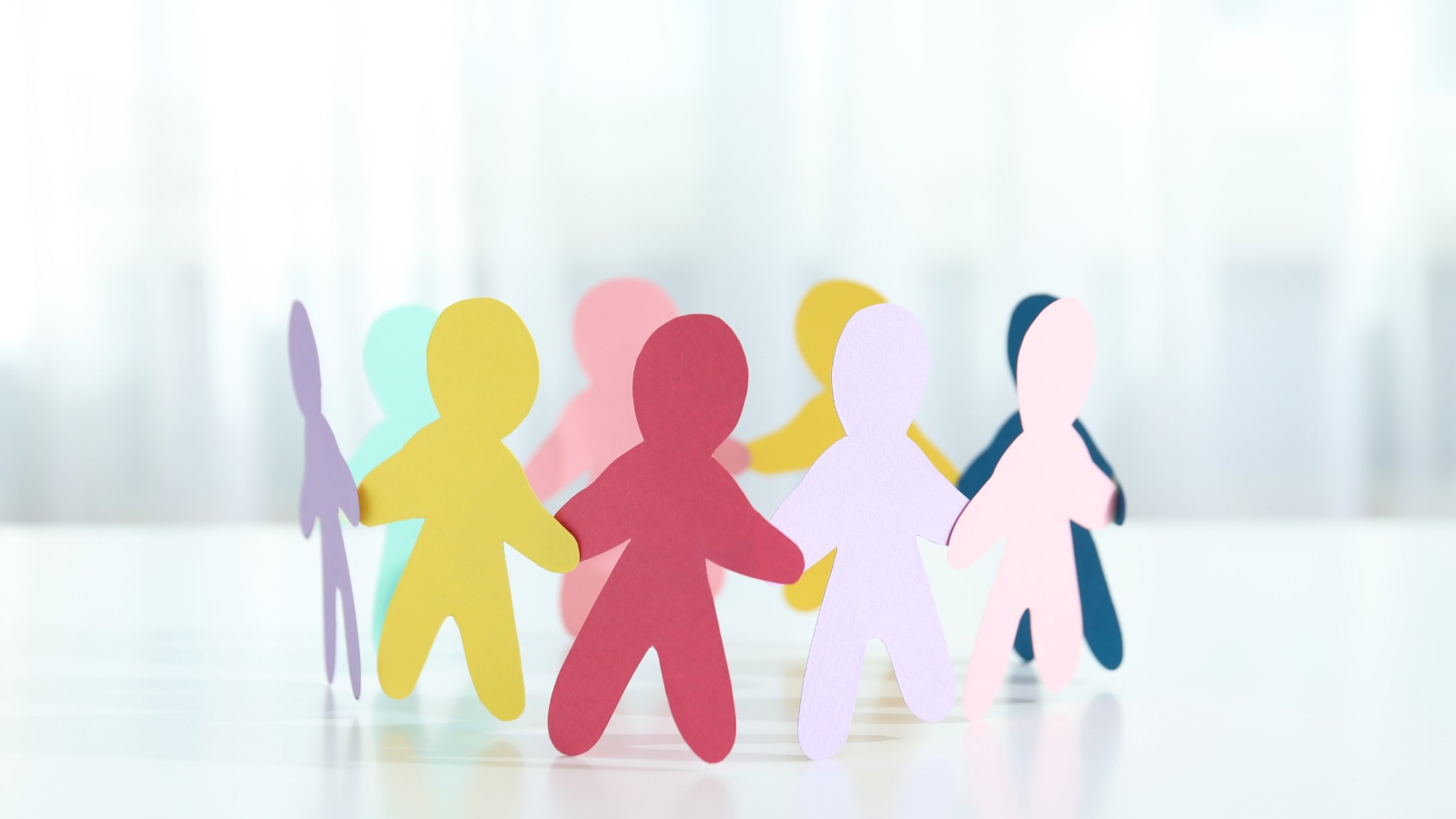Pride Month is just around the corner! And while it’s important to look back and celebrate the accomplishments of the LGBTQIA+ community thus far, it’s also a reminder of the work left to do—especially for allies of the community.
Over the past few years, many companies have made commitments around diversity, equity, and inclusion (DEI), but the unfortunate reality is that nearly half of all LGBTQIA+ employees report staying closeted at work. When employees feel as though they can’t be their true selves while on the clock, it quickly leads to issues across all pillars of wellness. So what’s the solution?
Policies are essential, but they can only go so far in creating a comfortable atmosphere. That’s where employee resource groups (ERGs) come in, providing critical on-the-ground peer support that not only fosters inclusivity and belonging, but also increases employee engagement, cultural awareness, and connection.
What Is an Employee Resource Group?
An employee resource group, also known as a business resource group, is a voluntary program designed to build employee connections around a common interest or shared identity. This sense of community and support is especially important for underrepresented groups, such as LGBTQIA+ members, Black employees, Asian American employees, and those with disabilities.
But ERGs aren’t limited to these groups either; some companies offer programs focused on career development, such as a Young Professionals ERG. No matter the unifying factor, effective ERGs are about supporting each other because of our differences—not despite them.
ERGs vs. Affinity Groups
The terms “ERG” and “affinity group” are often used interchangeably, but there is an important difference. While they’re both aimed at fostering community and social connection, affinity groups tend to be more informal, without a real focus.
On the other hand, ERGs are typically created with a mission in mind that ties back to the organization’s broader DEI goals—whether it’s a Pride ERG to support LGBTQIA+ workers, a Black employee network to uplift African American voices in the company, or a Disability ERG to ensure and equitable work environment.
The Wellness Benefits of Business ERGs
Because employers work with ERG leaders and members to align on strategic DEI goals, these programs offer a unique array of workplace wellness benefits, including:
- Provide employees with social support: An ERG program offers more than just networking opportunities—it facilitates social connections, with 66% of employees reporting a better sense of community as a direct result.
- Improve cultural competency: ERGs for underrepresented groups serve an important role in educating employees about cultural diversity and how to be a better ally.
- Reduce stress in the workplace: Effective ERGs address the concerns of workers, reducing stress while improving job satisfaction and employee retention.
- Develop professional skills: ERG leaders can organize events focused on professional development to help employees build their skills and grow in their careers.
- Empower meaningful advocacy: Beyond just the workplace, ERG members can work on initiatives that drive meaningful change in their local area through community outreach.
So how can employers create their own? Let’s start with a Pride ERG as an example:
How To Start an LGBTQIA+ Pride ERG in the Workplace
- Assess Interest and Need
Start by tapping into the pulse of the organization. Employers who are looking to start a Pride ERG will likely already recognize the need for this kind of safe space, but it’s important to gather more insights. Try deploying a survey or hosting interactive focus groups to understand the specific needs of LGBTQIA+ employees and forecast potential membership. This data will allow employers to pinpoint key areas where support and advocacy are needed, getting a jumpstart on the next step. - Define Mission and Objectives
Once employers have a sense of what the ERG will look like, it’s time to craft a compelling mission statement with clear, outlined objectives. The mission should resonate deeply with both the community it serves—in this case, the LGBTQIA+ community—and the organization’s overall diversity goals. Leaders should also set specific, measurable objectives like increasing awareness, fostering employee connection, and promoting inclusion. A clear definition of what success looks like gives group members a guiding beacon around which to center their efforts. - Obtain Leadership Buy-in and Register the ERG
Of course, ERG leaders will likely be employees, but gaining support from the organization’s leadership will also be crucial. Many ERGs choose to have an executive sponsor. This is a C-level senior leader who is passionate about LGBTQIA+ issues and can bridge the gap between grassroots efforts and the strategic vision of the organization. Their sponsorship can further legitimize the ERG, especially as they champion the group’s initiatives and secure the resources required for operation. - Establish Group Structure and Leadership
While an executive sponsor is important, their role often focuses more on laying the foundation for success and offering high-level strategy insights. ERG leaders, on the other hand, are responsible for tasks like organizing events, managing communications, and maintaining the group’s strategic direction. Each group will need to elect an ERG leader and create its governance structure with clearly defined roles and responsibilities. This will ensure that there are motivated and accountable individuals steering the group toward its goals. - Plan and Execute Initiatives
With a strong leadership team and governance structure in place, it’s time to bring the ERG to life with meaningful initiatives. Whether it’s creating a safe space for employees to speak openly, hosting educational discussions about LGBTQIA+ topics, or celebrating Pride events, each activity should aim to enhance understanding of each other, build community, and support career growth. Planning these initiatives will require a lot of work, but they will also enrich the company’s culture and increase employee engagement. - Measure Impact and Maintain Momentum
Launching isn’t the last step; it’s only the beginning. Keeping the momentum alive will require continuous assessment and adaptation. To ensure the ERG thrives, it’s important to measure its impact. Use regular feedback mechanisms, such as surveys and event attendance, to gather valuable insights that help tweak and improve initiatives.
Best Practices for Running an Effective ERG
- Develop a Robust and Inclusive Membership Base
ERGs thrive on diversity. Aim to build a robust and inclusive membership base that reflects a wide spectrum of the workforce, including allies. This diversity can enrich the ERG’s activities and increase its impact across the organization. Group members should be encouraged to recruit colleagues at company events, through internal newsletters, and via word-of-mouth to keep the program active and growing. - Maintain Regular Communication
Keep open lines of communication with all ERG members and potential members. Regular meetings can help, but be sure to reach out across various channels, such as newsletters, social media, or even just group chats. The goal is to provide consistent, regular updates that keep members informed and engaged with the community’s efforts. - Promote Professional Development Opportunities
ERGs are powerful tools for positive change. A crucial aspect of them is how they can uplift community members through career development and professional growth opportunities. Offering workshops, seminars, mentorship programs, and training that cater to the community is critical for empowering employees. As they grow in their positions, they’ll propel the company further. - Engage in Meaningful Activities
While professional development is always meaningful—especially for underrepresented groups—ERGs should also plan activities that are purpose-driven and enjoyable. Whether it’s volunteering, celebrating different cultures, or hosting educational workshops, these events can provide employees with a deeper sense of purpose while aligning with the ERG’s overarching mission. - Join Corporate Functions to Raise Awareness
Visibility is key when it comes to ERG awareness. Presenting in meetings and contributing to the company newsletter can help, but participating in corporate functions and other company-wide events allows for a more personal level of community outreach. They’re the perfect opportunity to showcase the ERG’s goals, achievements, and value to the community, encouraging wider recognition and support. - Collaborate Across ERGs
Last but not least, encourage collaboration across different ERGs within the organization. Groups can share best practices, resources, and support. They can even work together on joint initiatives that address broader issues impacting multiple groups. This level of collaboration fosters a culture of inclusivity and mutual support, strengthening the network of ERGs and reinforcing their critical role in the company’s DEI strategy.
Elevate Your ERGs with WellRight
WellRight offers a comprehensive wellness platform for your ERGs to leverage. Tailor programs to unique employee needs and raise awareness for these initiatives to drive employee engagement.
Request a demo to see how we can help transform your organizational culture.



